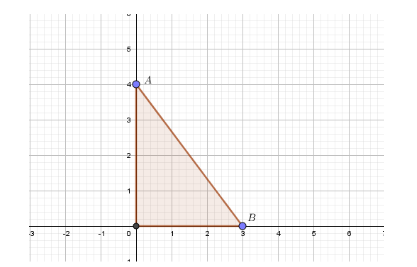
The perimeter of a triangle with vertices (0, 4), (0, 0) and (3, 0) is:
A. 8
B. 10
C. 12
D. 15
Answer
555.3k+ views
Hint: Here, mark the points on the graph, and join the lines to form a triangle. Using distance formula, find the length of three sides. Add the three lengths to find the perimeter of the triangle.
Complete step-by-step answer:
Let the points are A (0, 4), O (0, 0) and B (3, 0).

For length OA,
Using distance formula,
$ \Rightarrow OA = \sqrt {{{(0 - 0)}^2} + {{(4 - 0)}^2}} = \sqrt {16} = 4 $ units
For length OB,ss
Using distance formula,
$ \Rightarrow OB = \sqrt {{{(3 - 0)}^2} + {{(0 - 0)}^2}} = \sqrt 9 = 3 $ units
For length AB,
Using distance formula,
$ \Rightarrow AB = \sqrt {{{(0 - 3)}^2} + {{(4 - 0)}^2}} = \sqrt {9 + 16} = \sqrt {25} = 5 $ units
Perimeter of triangle ABC, $ P = AB + BC + AC $
P = 3 units + 4 units + 5 units = 12 units
So, the correct answer is “12 units”.
Note: In these types of questions, draw the figure on a graph to understand the question geometrically.One important thing about this question is that we can find hypotenuse using Pythagoras theorem as one angle in this question is right angle. Here, (0, 4) means length of this point from origin is 4 units and (3, 0) means length of this point from the origin is 3 units. Using these two lengths and Pythagoras theorem we can find the length of the third side. Add them to get the perimeter of the triangle.
Complete step-by-step answer:
Let the points are A (0, 4), O (0, 0) and B (3, 0).

For length OA,
Using distance formula,
$ \Rightarrow OA = \sqrt {{{(0 - 0)}^2} + {{(4 - 0)}^2}} = \sqrt {16} = 4 $ units
For length OB,ss
Using distance formula,
$ \Rightarrow OB = \sqrt {{{(3 - 0)}^2} + {{(0 - 0)}^2}} = \sqrt 9 = 3 $ units
For length AB,
Using distance formula,
$ \Rightarrow AB = \sqrt {{{(0 - 3)}^2} + {{(4 - 0)}^2}} = \sqrt {9 + 16} = \sqrt {25} = 5 $ units
Perimeter of triangle ABC, $ P = AB + BC + AC $
P = 3 units + 4 units + 5 units = 12 units
So, the correct answer is “12 units”.
Note: In these types of questions, draw the figure on a graph to understand the question geometrically.One important thing about this question is that we can find hypotenuse using Pythagoras theorem as one angle in this question is right angle. Here, (0, 4) means length of this point from origin is 4 units and (3, 0) means length of this point from the origin is 3 units. Using these two lengths and Pythagoras theorem we can find the length of the third side. Add them to get the perimeter of the triangle.
Recently Updated Pages
Master Class 11 Chemistry: Engaging Questions & Answers for Success

Why are manures considered better than fertilizers class 11 biology CBSE

Find the coordinates of the midpoint of the line segment class 11 maths CBSE

Distinguish between static friction limiting friction class 11 physics CBSE

The Chairman of the constituent Assembly was A Jawaharlal class 11 social science CBSE

The first National Commission on Labour NCL submitted class 11 social science CBSE

Trending doubts
What is meant by exothermic and endothermic reactions class 11 chemistry CBSE

10 examples of friction in our daily life

One Metric ton is equal to kg A 10000 B 1000 C 100 class 11 physics CBSE

Difference Between Prokaryotic Cells and Eukaryotic Cells

What are Quantum numbers Explain the quantum number class 11 chemistry CBSE

1 Quintal is equal to a 110 kg b 10 kg c 100kg d 1000 class 11 physics CBSE




